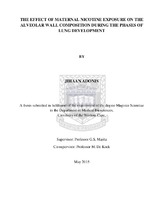| dc.contributor.advisor | Maritz, G.S. | |
| dc.contributor.advisor | De Kock, M. | |
| dc.contributor.author | Adonis, Jihaan | |
| dc.date.accessioned | 2016-01-05T10:10:54Z | |
| dc.date.available | 2016-01-05T10:10:54Z | |
| dc.date.issued | 2015 | |
| dc.identifier.uri | http://hdl.handle.net/11394/4704 | |
| dc.description | Magister Scientiae (Medical Bioscience) - MSc(MBS) | en_US |
| dc.description.abstract | Cigarette smoking is one of the foremost causes of chronic obstructive pulmonary diseases such as emphysema and chronic bronchitis, and although it is the most preventable causes of death, it accounts for approximately 6 million deaths worldwide each year. Cigarette smoking during pregnancy and lactation remains one of the primary modifiable risk factors for undesirable fetal, obstetrical, and developmental outcomes. Consequently, the offspring of the smoking mother is exposed to nicotine via the blood and the milk of the mother. As a result, nicotine interacts with the developing offspring and therefore interferes with normal fetal lung development. Maternal smoking during gestation and lactation has been associated with both short and long term health risks ranging from intrauterine growth restriction to physiological abnormalities. Maternal smoking has also been strongly linked to an increased risk for pulmonary diseases and respiratory morbidity in the offspring of the smoking mother. The main objectives of this study were to determine the effects of maternal nicotine exposure during gestation and lactation on the alveolar wall composition during lung development in the offspring; if maternal nicotine exposure during gestation and lactation induces premature cellular senescence in the lungs of the offspring; to clarify the role of pulmonary fibroblasts in premature senescence; and to establish whether tomato juice supplementation will prevent premature aging in the lungs of rats that were exposed to nicotine via the placenta and mother’s milk. From the data generated in this study it was evident that maternal nicotine exposure during gestation and lactation compromises the gas exchange function of the lungs of the F1 offspring. This was prevented by supplementing the mother’s diet with tomato juice which is then received by the offspring via the placenta and mother’s milk. This is conceivably achieved by maintaining the oxidant-anti-oxidant ratio of the mother and of the developing fetus and neonate, thereby averting premature senescence caused by nicotine exposure. Moreover, the present study also demonstrates that a decrease in fibroblast density is associated with emphysematous-like lesions in the lungs of the nicotine exposed F1 progeny. Since pulmonary fibroblasts are chief contributors to the extracellular matrix of the lungs, involved in alveolar multiplication and regeneration; premature aging or cessation of the metabolically active fibroblasts largely contributes to diminished lung structure and function. | en_US |
| dc.language.iso | en | en_US |
| dc.publisher | University of the Western Cape | en_US |
| dc.subject | Cigarette smoking | en_US |
| dc.subject | Pulmonary fibroblasts nicotine | en_US |
| dc.subject | Maternal exposure | en_US |
| dc.subject | Lung development | en_US |
| dc.subject | Tomato juice | en_US |
| dc.subject | Premature aging | en_US |
| dc.title | The effect of maternal nicotine exposure on the alveolar wall composition during the phases of lung development | en_US |
| dc.type | Thesis | en_US |
| dc.rights.holder | University of the Western Cape | en_US |

